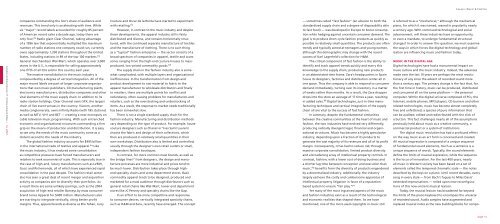Testimony of David Wolfe, Creative Director The ... - Public Knowledge
Testimony of David Wolfe, Creative Director The ... - Public Knowledge
Testimony of David Wolfe, Creative Director The ... - Public Knowledge
You also want an ePaper? Increase the reach of your titles
YUMPU automatically turns print PDFs into web optimized ePapers that Google loves.
E s s a y s : M u s i c & F a s h i o n<br />
companies commanding the lion’s share <strong>of</strong> audience and<br />
revenues. This trend only is accelerating with time. While<br />
Couture and Oscar de la Renta have started to experiment<br />
with retailing. 65<br />
— sometimes called “fast fashion” (an allusion to both the<br />
standardized supply chain and a degree <strong>of</strong> disposability akin<br />
is referred to as a “mechanical,” although the mechanical<br />
piano, for which it was named, waned in popularity nearly<br />
six “major” record labels accounted for roughly 85 percent<br />
However, in contrast to the music industry and despite<br />
to fast food) — was developed in Europe to boost consump-<br />
a century ago. With continued technological and social<br />
<strong>of</strong> American record sales a decade ago, today there are<br />
these developments, the apparel industry still is fairly<br />
tion while hedging against uncertain consumer demand. <strong>The</strong><br />
advancement, will these industries have an opportunity,<br />
only four. 62 Radio giant Clear Channel, taking advantage<br />
distributed and diverse, and remains horizontally struc-<br />
goal is to produce short-cycle fashion products as quickly as<br />
or even a mandate, to undergo fundamental structural<br />
<strong>of</strong> a 1996 law that exponentially multiplied the maximum<br />
tured, with the continued separate manufacture <strong>of</strong> textiles<br />
possible in relatively small quantities. <strong>The</strong> products are <strong>of</strong>ten<br />
changes? In order to answer this question, we must examine<br />
number <strong>of</strong> radio stations one company could run, currently<br />
and the manufacture <strong>of</strong> clothing. <strong>The</strong>re is no such thing<br />
trendy and typically aimed at teenagers and young women,<br />
the ways in which forces like digital technology and global-<br />
page 60 | Ready to Share: Fashion & the Ownership <strong>of</strong> Creativity<br />
owns approximately 1,200 stations throughout the United<br />
States, including stations in 89 <strong>of</strong> the top 100 markets. 63<br />
General merchandiser Wal-Mart, which operates over 3,000<br />
stores in the U.S., is responsible for selling approximately<br />
one-fifth <strong>of</strong> all CDs sold in this country each year.<br />
<strong>The</strong> massive consolidation in the music industry is<br />
compounded by a degree <strong>of</strong> vertical integration. All <strong>of</strong> the<br />
major record labels are part <strong>of</strong> larger corporate organizations<br />
that own music publishers, CD manufacturing plants,<br />
electronics manufacturers, distribution companies and other<br />
vital elements <strong>of</strong> the music supply chain. In addition to its<br />
radio-station holdings, Clear Channel owns SFX, the largest<br />
chain <strong>of</strong> live event venues in the country. Viacom, another<br />
media conglomerate, owns Infinity Radio (with 185 stations)<br />
as well as MTV, VH1 and BET — creating a near monopoly on<br />
cable television music programming. With such entrenched<br />
economic and organizational structures commanding a firm<br />
grip on the means <strong>of</strong> production and distribution, it is easy<br />
to see why the needs <strong>of</strong> the music community come as a<br />
as a “typical” fashion enterprise — the sector consists <strong>of</strong> a<br />
broad spectrum <strong>of</strong> companies in apparel, textile and accessories<br />
ranging from the high-end couture houses to massproduced,<br />
low-priced commodity goods. 66<br />
<strong>The</strong> supply chain in the fashion industry also is somewhat<br />
complicated, with multiple layers and organizational<br />
inefficiencies. In the transformation from design and<br />
product development to raw material to fabric to the<br />
apparel manufacturer to wholesale distributors and finally<br />
to retailers, there are multiple points for conflict and<br />
redundancy, <strong>of</strong>ten causing problems for manufacturers and<br />
retailers, such as the overstocking and understocking <strong>of</strong><br />
items. As a result, the response to market needs traditionally<br />
has been somewhat slow.<br />
<strong>The</strong>re is not a single standard supply chain for the<br />
fashion industry. Manufacturing and distribution methods<br />
vary depending on the type <strong>of</strong> product. For example, haute<br />
couture designers such as Chanel or Yves Saint Laurent<br />
choose the fabric and design <strong>of</strong> their collections, which<br />
although this demographic may change with the recent<br />
success <strong>of</strong> Karl Lagerfeld’s collection for H&M.<br />
<strong>The</strong> critical component <strong>of</strong> fast fashion is the ability to<br />
identify and track apparel trends quickly and marry this<br />
knowledge to the supply chain, producing new products<br />
in an abbreviated time frame. Zara’s headquarters in Spain<br />
house its designers, factories and distribution center all in<br />
one space. Thus the company is able to respond to consumer<br />
demand immediately, turning over its inventory in a matter<br />
<strong>of</strong> weeks rather than months. As a result, the Zara shopper<br />
drops into the store an average <strong>of</strong> 17 times a year, resulting<br />
in added sales. 68 Digital technologies, just-in-time manufacturing<br />
techniques and vertical integration <strong>of</strong> the supply<br />
chain all are vital to the success <strong>of</strong> fast fashion.<br />
In summary, despite the fundamental similarities<br />
between the creative communities at the heart <strong>of</strong> music and<br />
fashion, the two industries have evolved very differently,<br />
producing radically divergent legal, financial and organizational<br />
structures. Music has become a highly speculative<br />
ization are influencing music and fashion today.<br />
music in the digital age<br />
Digital technologies have had a monumental impact on<br />
music culture and the music industry. Indeed, the advances<br />
made over the last 10 years are perhaps the most revolutionary<br />
<strong>of</strong> any since the advent <strong>of</strong> recorded sound more<br />
than a century ago. <strong>The</strong> primary change is the fact that, for<br />
the first time in history, music can be produced, distributed<br />
and consumed all on the same platform — the personal<br />
computer. Within the digital universe composed <strong>of</strong> PCs, the<br />
Internet, mobile phones, MP3 players, CD burners and other<br />
related technologies, music has become almost completely<br />
free and unfettered, a species <strong>of</strong> pure information that<br />
can be audited, edited and redistributed with the click <strong>of</strong><br />
a button. This fact challenges nearly all <strong>of</strong> the assumptions<br />
previously held about music as a creative community, a<br />
commercial product or a system <strong>of</strong> institutions.<br />
<strong>The</strong> digital music revolution has had a pr<strong>of</strong>ound effect<br />
distant second to the needs <strong>of</strong> the industry.<br />
then are produced in relatively small quantities in their<br />
industry, depending upon a fraction <strong>of</strong> its products to<br />
on the way music as an art form is conceived and created.<br />
<strong>The</strong> global fashion industry accounts for $495 billion<br />
own workshops. Distribution also is limited and controlled,<br />
generate the vast majority <strong>of</strong> its revenues and all <strong>of</strong> its pr<strong>of</strong>it<br />
All musical expression is composed <strong>of</strong> a unique sequence<br />
in the international trade <strong>of</strong> textiles and apparel. 64 Like<br />
usually through the designer’s own retail outlets or small,<br />
margin. Consequently, it has had to reduce risk through<br />
<strong>of</strong> fundamental sound elements, much as a sentence is a<br />
the music industry, it has endured some consolidation<br />
independent fashion boutiques.<br />
massive corporate consolidation, limited product diversity<br />
unique sequence <strong>of</strong> words. Typically, the sound elements<br />
as competitive pressures have forced manufacturers and<br />
In contrast, for more common mass brands, as well as<br />
and a broadening array <strong>of</strong> intellectual property controls. In<br />
define the limits <strong>of</strong> musical expression, while the sequence<br />
retailers to seek economies <strong>of</strong> scale. This is especially true in<br />
the bridge lines 67 from designers, the design and manu-<br />
contrast, fashion, with a lower cost <strong>of</strong> doing business and<br />
is the locus <strong>of</strong> innovation. For the last 400 years, nearly<br />
the case <strong>of</strong> high-end, luxury manufacturers such as LVMH,<br />
facture processes are more industrial and prices tend to<br />
a shorter lag time between conception and execution than<br />
all music in Western society has been based on a set <strong>of</strong><br />
Gucci and Richemonde, all <strong>of</strong> which have experienced rapid<br />
be much lower. Distribution takes place through high-<br />
music, 69 benefits from the diversity <strong>of</strong> products engendered<br />
elements called the tempered chromatic scale — the notes<br />
consolidation in the past decade. <strong>The</strong> fashion retail sector<br />
end specialty chains and some department stores. Basic<br />
by a decentralized industry. Additionally, the industry<br />
described by the keys on a piano. Until recent decades, every<br />
also has seen a great deal <strong>of</strong> recent merger and acquisition<br />
commodity apparel tends to be designed, produced and<br />
largely eschews the costly and cumbersome apparatus <strong>of</strong><br />
song in every style — from Bach’s fugues to Miles Davis’<br />
activity as companies aim to diversify their portfolios. As<br />
a result there are some unlikely pairings, such as the 2004<br />
marketed for a mass audience through distributors such as<br />
general retail chains like Wal-Mart, lower-end department<br />
intellectual property litigation in favor <strong>of</strong> a reputationbased<br />
system to ensure “fair play.” 70<br />
extended improvisations — relied upon new reconfigurations<br />
<strong>of</strong> this now-ancient musical lexicon.<br />
acquisition <strong>of</strong> high-end retailer Barneys by mass consumer<br />
stores like JC Penney and specialty chains like the Gap.<br />
Yet many <strong>of</strong> the most ingrained aspects <strong>of</strong> the music<br />
Today, the musical lexicon has broadened far beyond<br />
brand Jones Apparel for $400 million. Manufacturers also<br />
In an effort to be more competitive and responsive<br />
and fashion industries exist as a result <strong>of</strong> the technological<br />
the limits <strong>of</strong> the piano keyboard to encompass the universe<br />
are starting to integrate vertically, citing better pr<strong>of</strong>it<br />
to consumer desires, vertically integrated specialty chains,<br />
and economic realities that shaped them. As we have<br />
<strong>of</strong> recorded sound. Audio samples have augmented and<br />
margins. Thus, apparel brands as diverse as Elie Tahari, Juicy<br />
such as H&M and Zara, recently have emerged. <strong>The</strong> concept<br />
mentioned, one <strong>of</strong> the most-used copyrights in music still<br />
replaced musical notes as the new building blocks for compo-<br />
page 61





